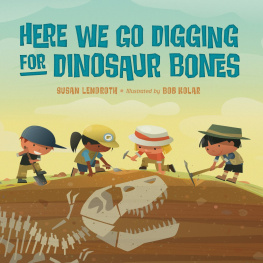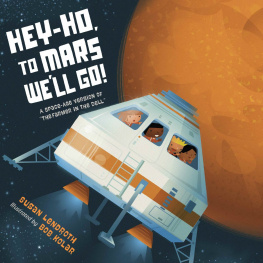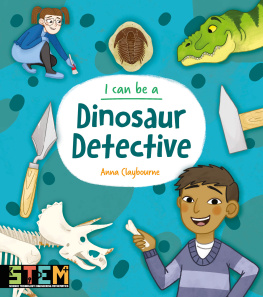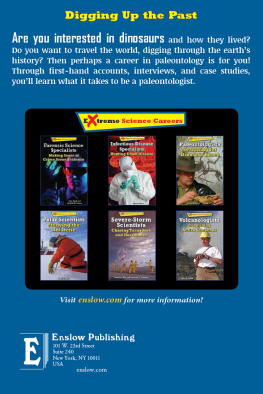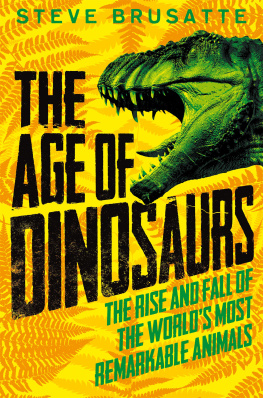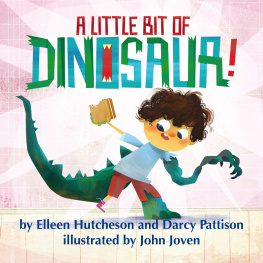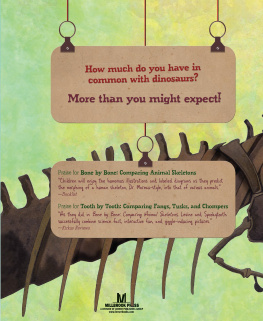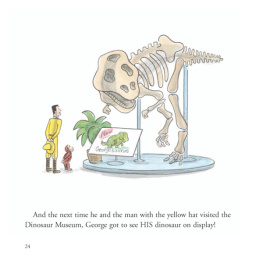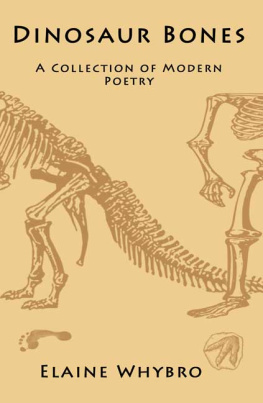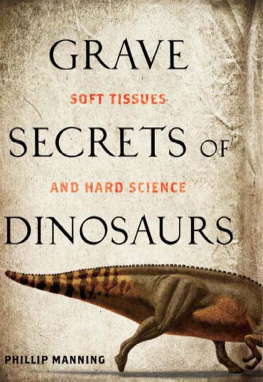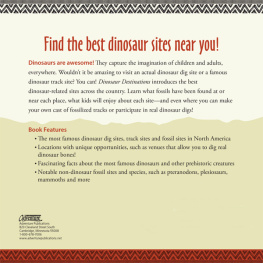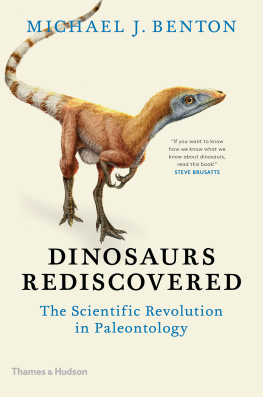Many people, from workers constructing a new
building to children playing in a field, have found
dinosaur bones by accident. But scientists travel
all over the world to the places they think
offer the best chance of finding fossils.
HEREWEGODIGGINGfordinosaurbones,dinosaurbones,dinosaurbones.Herewegodiggingfordinosaurbonesonawarmandsunnymorning.
Thisisthewaywehikethetrail,hikethetrail,hikethetrail.
Fossils are the remains of animals and
plants that died long ago. Paleontologists
are scientists who study fossils. They hunt
for them in areas where rocks formed
millions of years ago.
Thisisthewaywehikethetrailonawarmandsunnymorning.
Thisisthewaywescantheground,scantheground,
Sometimes, when a dinosaur died,
mud or sand quickly covered its body.
Over time the body decomposed, leaving
behind just the skeleton. Minerals slowly
replaced the bones, creating fossils.
scantheground.Thisisthewaywescanthegroundonawarmandsunnymorning.
Thisisthewayweexcavate,excavate,excavate.
When paleontologists find a dinosaur fossil,
they dig around it to look for more pieces
of the dinosaur. They also may find fossils
of plants and other animals from the same
time period.
Thisisthewayweexcavateonawarmandsunnymorning.
Thisisthewaywesiftthroughdirt,siftthroughdirt,
Fossils can be as big as a refrigerator or as
small as a grain of sand. To build a dinosaur
skeleton, paleontologists want to find every
scrap available. They sift dirt through wire
screens to find the teeny-tiny bits.
siftthroughdirt.Thisisthewaywesiftthroughdirtonawarmandsunnymorning.
Thisisthewaywewrapourfinds,wrapourfinds,wrapourfinds.
Sometimes its safer to leave a large fossil in a
surrounding block of stone and to lift it out as one large
piece. Paleontologists wrap the block in cloth, paper
towels, or even toilet paper. They then cover it with a
hard layer of plaster to protect it during transportation.
Thisisthewaywewrapourfindsonawarmandsunnymorning.
Thisisthewaywecleanthebones,cleanthebones,
Back in the laboratory, scientists and
technicians carefully clean each fossil.
They use chemicals, chisels, brushes, and
the picks your dentist uses on your teeth.
cleanthebones.Thisisthewaywecleanthebonesonawarmandsunnymorning.
Thisisthewaywestudybones,studybones,studybones.
Dinosaurs lived millions of years ago, but we
have a good idea of what they looked like from
their fossils. Paleontologists study fossilized
bones like a jigsaw puzzle to decide what goes
where when building a dinosaur skeleton.
Thisisthewaywestudybonesonawarmandsunnymorning.
This is the way we build T. rex ,
build T. rex ,
build T. rex .
Most fossil skeletons are not complete when
they are found. Paleontologists figure out what
the missing parts should be and make models
of them. All the pieces, both the fossils and the
reproductions, are fitted together on a metal
frame to build a dinosaur skeleton.
ThisisthewaywebuildT.rexonawarmandsunnymorning.
Thisisthewayitbaresitsteeth,baresitsteeth,baresitsteeth.
T. Rex had more than fifty large teeth in
its massive jaws, some up to a foot long.
Scientists think it may have had the most
powerful bite of any land animal ever.
Thisisthewayitbaresitsteeth.onawarmandsunnymorning.
Letsgodiggingfordinosaurbones,dinosaurbones,dinosaurbones.
Fossils can be found in many
places, and anyone can hunt for
them, even kids. What dinosaurs
would you like to find?
Letsgodiggingfordinosaurbonesonawarmandsunnymorning.
Dinos and Fossils and Birds, Oh My!
Dinosaurs walked the earth for more than 180 million years, but
not all types of dinosaurs lived at the same time. For example, tens
of millions of years passed between the era of the Stegosaurus and
that of Tyrannosaurus rex . By comparison, modern humans, Homo
sapiens , have existed for about two hundred thousand years.
PATAGOTITANSTEGOSAURUSTYRANNOSAURUSREX
Dinosaurs came in many shapes and sizes. Compsognathus
was as small as a chicken. One of the largest dinosaurs, Patagotitan ,
weighed in at nearly 70 tonsheavier than ten African
elephants! New dinosaur species are still being discovered,
so one day someoneperhaps youmay find
one thats even larger.
People have been finding fossils for thousands of years,
but scientists did not realize that these were from prehistoric
animals until the 1800s. Paleontologists have discovered
not only fossilized bones and teeth, but also the remains of
dinosaur eggs, skin, feathers, footprints, and even poop. All
these fossils give clues to how dinosaurs looked and lived,
but new discoveries constantly change our understanding. For
example, researchers now think many (perhaps most) dinosaurs
had feathers, even though they did not fly.
sparrow
COMPSOGNATHUS
Scientists believe a large asteroid impacted Earth sixty-five
million years ago, leading to the extinction of the dinosaurs.
Not all dinosaurs died at that time, though. A few survived to
evolve into the birds we know today. When you see sparrows
hopping on the ground or a hawk soaring with the wind, you
are looking at descendants of the dinosaurs.
Read, Sing, and Dig!
Paleontologists hike, dig, and build. You can, too!
Act out the story as you sing along with the book.
This is the way we HIKE
the trail: Swing your arms
back and forth as though
walking with a purpose.
SCAN the ground:
Put a hand above
your eyes and
search the room.
EXCAVATE :
Dig with your
invisible shovel.
SIFT through dirt:
Imagine holding a tray
between your hands and
shaking it back and forth.
WRAP our finds:
Pretend you are
winding a bandage
around your arm.
CLEAN the bones:
Cup one hand and
use the other as
a scrub brush.
STUDY bones: Curl
both hands into tubes
to form a microscope
and peer through it.
BUILD T. Rex : Stack your
fists higher and higher.
And everyone can BARE their teeth
and chomp like a dinosaur!
The illustrations for this story are set in Montanas Hell Creek
Formation, a well-known site for fossil digs. Scattered through
the art are some of the critters that live in that area today.
Can you find them?
western
meadowlark
western
tanager
greater
short-horned
lizard
red-winged
blackbird
plains
spadefoot toad
western
milk snake
To my old friends Susan (Getz) Lyon and Denise
(Woo) Seymour: Sue, Sue, and Woo forever!
(And Im not saying were dinosaurs.) S. L.
For Everett B. K.
Special thanks to Alan Zdinak, fossil preparator at the Natural History Museum of
Los Angeles County, and Carol J. Stadum, associate in the paleontology department
at the San Diego Natural History Museum, for their invaluable advice and expertise.
Text copyright 2020 by Susan Lendroth
Illustrations copyright 2020 by Bob Kolar
All rights reserved, including the right of reproduction in
whole or in part in any form. Charlesbridge and colophon
are registered trademarks of Charlesbridge Publishing, Inc.
Published by Charlesbridge
85 Main Street, Watertown, MA 02472
(617) 926-0329 www.charlesbridge.com
Printed in China
(hc) 10 9 8 7 6 5 4 3 2 1
Artwork was created with a computer using lots of pixels
(no dinosaurs were harmed in the creation of this book)

